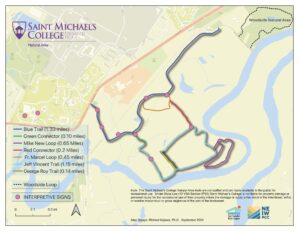The Natural Area
The Natural Area
The Saint Michael’s campus covers 440 acres in suburban Colchester and Essex, but until recently, most of the college community experienced a small fraction of this total. Starting in 2016, the College began paying closer attention to the 340 campus acres surrounding the academic campus and opening the area up for exploration and learning.
The Natural Area is undeveloped and includes wetlands, sandplain forest, floodplain forest, and fields to explore. A small portion of this area is occupied by our solar array, compost facility, waste-water pumping station, geothermal infrastructure to heat the newest campus building, and salt, mulch, and topsoil staging necessary for maintaining the grounds.
The vision for this property is to restore and improve natural habitats in this area while expanding research, education, and recreational opportunities for the college community.
The Nature Trail
Check out the Nature Trail in the Saint Michael's College Natural Area.
Learn More
Restoration efforts
During the fall of 2017, 40 students used rakes to reduce accumulated organic material on the floor of the remnant sandplain forest. This treatment exposed mineral soil mimicking one of the effects of forest fires that regularly burned through sandplain forests prior to European settlement.
In the spring and fall of 2018, students in an environmental studies course planted more than 150 trees in a protective buffer along an exposed portion of the Winooski River bank. Riparian buffers retain soil, reduce erosion, and promote biological diversity. This and future plantings will accumulate carbon, soil organic material, and reduce phosphorus pollution entering Lake Champlain.
Tree planting has continued in the Natural Area, including over transplanting 100 hundred trees in May 2022 to help continue restoration efforts and environmental impacts. You can check out a video of a recent tree planting event below.
Corn was planted for the last time in 2018 and was replaced by a cover crop of winter rye to build up soil organic content and reduce soil erosion.
The goal is to expand existing wetlands to approximate their historical extent and establish approximately 60 acres of floodplain forest, as well expand habitat restoration.
Student and staff volunteers devoted a Saturday in October 2018 to cleaning up the area adjacent to the compost. A large tractor tire and a dozen bags of trash were removed and the location was significantly improved by the work.
Research
Beginning in Spring 2017, Saint Michael’s students have deployed up to 21 trail cameras at a time to document mammal communities and study microhabitat usage and human impacts on mammal distributions in the Natural Area. Sixteen mammal species have been recorded including coyotes, fishers, white-tailed deer and even the occasional bobcat. Thus far nine student researchers have participated in the project as summer interns and/or earned academic credit. The results of these studies have been presented in the Forest Ecosystem Monitoring Cooperative Conference and the Northeast Natural History Conference.
Commercial drones have flown over the landscape to capture high-resolution images of the site before large-scale restoration takes place. As part of this mapping effort, a series of fixed geo-referenced targets have been placed onsite and are also being used as permanent reference locations for both aerial and ground-based photography.
All on-site research has the potential to also be used directly for educational purposes or to provide content for Saint Michael’s classes.
Education
In addition to the research mentioned above, several other courses make use of the Natural Area for labs and scientific study.
Environmental Science students (ES 107) use the Natural Area as a source of comparative soil and water samples. In Fall 2018 the students sampled soil in the corn fields, sandplain forest, wetland, and floodplain forest. Water samples were compared between streams traversing the Natural Area and those draining campus.
Animal Behavior (BI 260) students deploy trail cameras each spring to capture video of mammals and birds in action. Students research teams are assigned two cameras to place in contrasting habitats to gather data over four to six weeks. A video compiled by the 2018 students provides a sampling of their observations.

Recreation
In anticipation of increased activity in the Natural Area, the College posted the entire property line against hunting. The new signs are placed no more than 400 feet apart along the Natural Area boundary and serve as a reminder that the site activities are incompatible with hunting.
Saint Michael’s has established a trail across the Natural Area that connects to the adjacent Woodside Natural Area trail at the northeast end of the property. This 1.3 mile trail connects to Woodside Avenue providing easy access to an additional 1-mile trail loop.
The College’s Wellness Cooperative collaborated with the Department of Environmental Studies and Science to fund trail markers that were installed during summer 2018. The markers are numbered to facilitate nature trails and other uses.
Trail kiosks were built by the Saint Michael’s College Carpenter Shop at each end of the new trail using material purchased by the Dean’s Office and Professor Richard Kujawa, a geographer and cartographer, created a trail map that has been posted at each of the kiosks.
The newly-established trail has attracted many users from the college community. In addition to casual hiking and dog walking through the property, both the women’s and men’s cross country running teams use the trail for workouts. Snow provides an opportunity for cross-country skiing and snowshoeing. The Vermont birding community has also discovered the site listing it as a birding hotspot on their web site.

